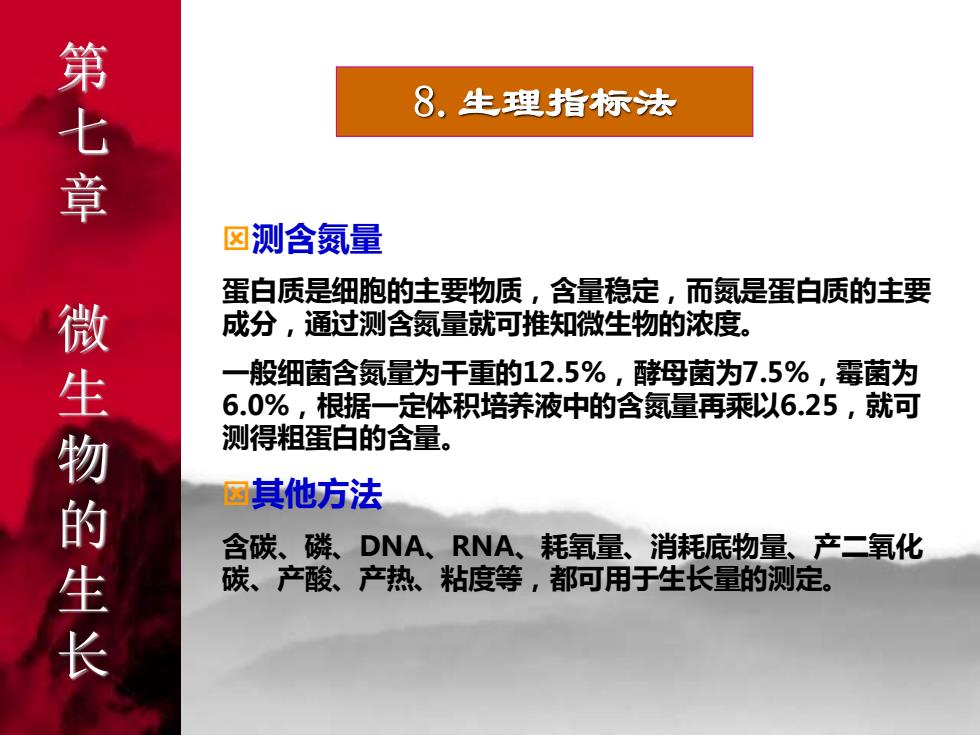
第 七 章 微 生 物 的 生 长 8.生理指标法 测含氮量 蛋白质是细胞的主要物质,含量稳定,而氮是蛋白质的主要 成分,通过测含氮量就可推知微生物的浓度。 一般细菌含氮量为干重的12.5%,酵母菌为7.5%,霉菌为 6.0%,根据一定体积培养液中的含氮量再乘以6.25,就可 测得粗蛋白的含量。 其他方法 含碳、磷、DNA、RNA、耗氧量、消耗底物量、产二氧化 碳、产酸、产热、粘度等,都可用于生长量的测定
第 七 章 微 生 物 的 生 长 8.生理指标法 测含氮量 蛋白质是细胞的主要物质,含量稳定,而氮是蛋白质的主要 成分,通过测含氮量就可推知微生物的浓度。 一般细菌含氮量为干重的12.5%,酵母菌为7.5%,霉菌为 6.0%,根据一定体积培养液中的含氮量再乘以6.25,就可 测得粗蛋白的含量。 其他方法 含碳、磷、DNA、RNA、耗氧量、消耗底物量、产二氧化 碳、产酸、产热、粘度等,都可用于生长量的测定
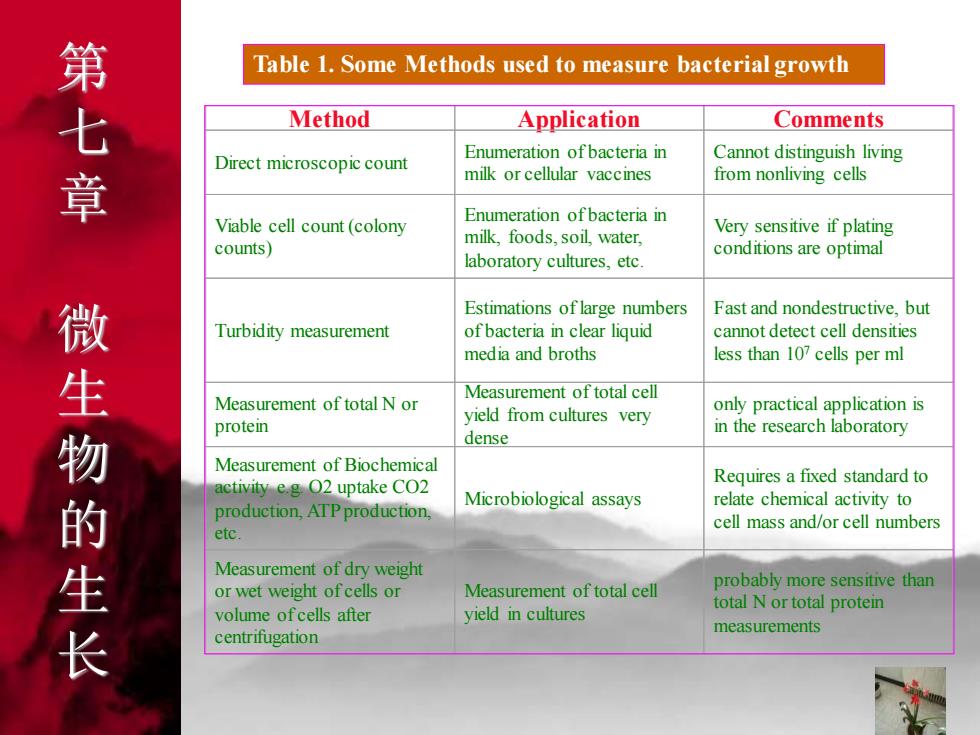
第 七 章 微 生 物 的 生 长 Table 1. Some Methods used to measure bacterial growth Method Application Comments Direct microscopic count Enumeration of bacteria in milk or cellular vaccines Cannot distinguish living from nonliving cells Viable cell count (colony counts) Enumeration of bacteria in milk, foods, soil, water, laboratory cultures, etc. Very sensitive if plating conditions are optimal Turbidity measurement Estimations of large numbers of bacteria in clear liquid media and broths Fast and nondestructive, but cannot detect cell densities less than 107 cells per ml Measurement of total N or protein Measurement of total cell yield from cultures very dense only practical application is in the research laboratory Measurement of Biochemical activity e.g. O2 uptake CO2 production, ATP production, etc. Microbiological assays Requires a fixed standard to relate chemical activity to cell mass and/or cell numbers Measurement of dry weight or wet weight of cells or volume of cells after centrifugation Measurement of total cell yield in cultures probably more sensitive than total N or total protein measurements
第 七 章 微 生 物 的 生 长 Table 1. Some Methods used to measure bacterial growth Method Application Comments Direct microscopic count Enumeration of bacteria in milk or cellular vaccines Cannot distinguish living from nonliving cells Viable cell count (colony counts) Enumeration of bacteria in milk, foods, soil, water, laboratory cultures, etc. Very sensitive if plating conditions are optimal Turbidity measurement Estimations of large numbers of bacteria in clear liquid media and broths Fast and nondestructive, but cannot detect cell densities less than 107 cells per ml Measurement of total N or protein Measurement of total cell yield from cultures very dense only practical application is in the research laboratory Measurement of Biochemical activity e.g. O2 uptake CO2 production, ATP production, etc. Microbiological assays Requires a fixed standard to relate chemical activity to cell mass and/or cell numbers Measurement of dry weight or wet weight of cells or volume of cells after centrifugation Measurement of total cell yield in cultures probably more sensitive than total N or total protein measurements
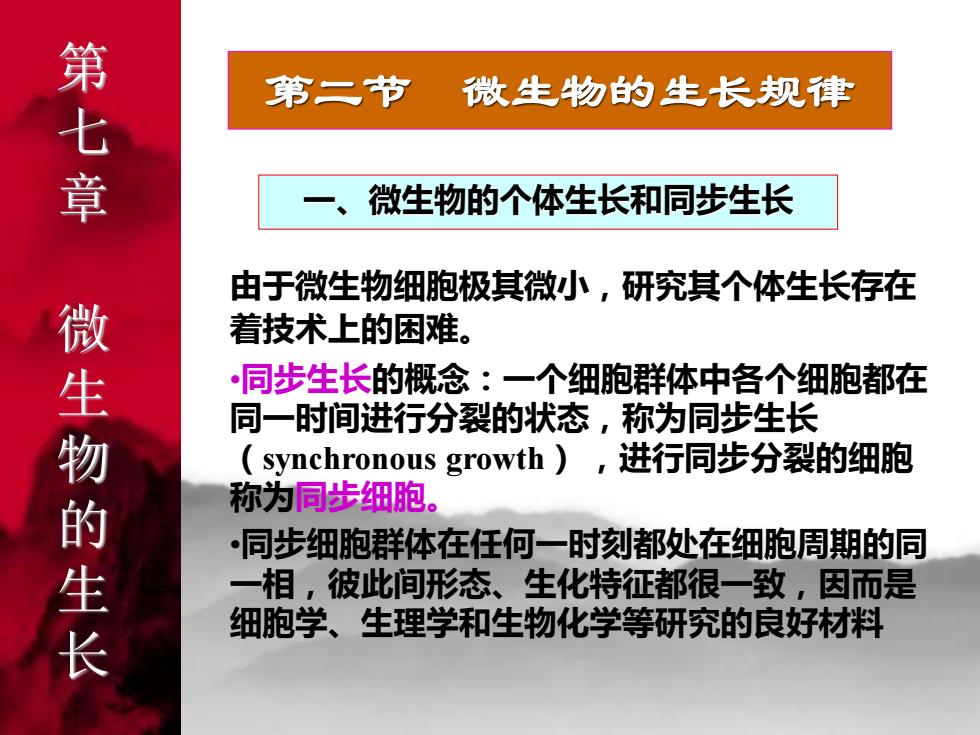
第 七 章 微 生 物 的 生 长 第二节 微生物的生长规律 一、微生物的个体生长和同步生长 由于微生物细胞极其微小,研究其个体生长存在 着技术上的困难。 •同步生长的概念:一个细胞群体中各个细胞都在 同一时间进行分裂的状态,称为同步生长 (synchronous growth) ,进行同步分裂的细胞 称为同步细胞。 •同步细胞群体在任何一时刻都处在细胞周期的同 一相,彼此间形态、生化特征都很一致,因而是 细胞学、生理学和生物化学等研究的良好材料
第 七 章 微 生 物 的 生 长 第二节 微生物的生长规律 一、微生物的个体生长和同步生长 由于微生物细胞极其微小,研究其个体生长存在 着技术上的困难。 •同步生长的概念:一个细胞群体中各个细胞都在 同一时间进行分裂的状态,称为同步生长 (synchronous growth) ,进行同步分裂的细胞 称为同步细胞。 •同步细胞群体在任何一时刻都处在细胞周期的同 一相,彼此间形态、生化特征都很一致,因而是 细胞学、生理学和生物化学等研究的良好材料
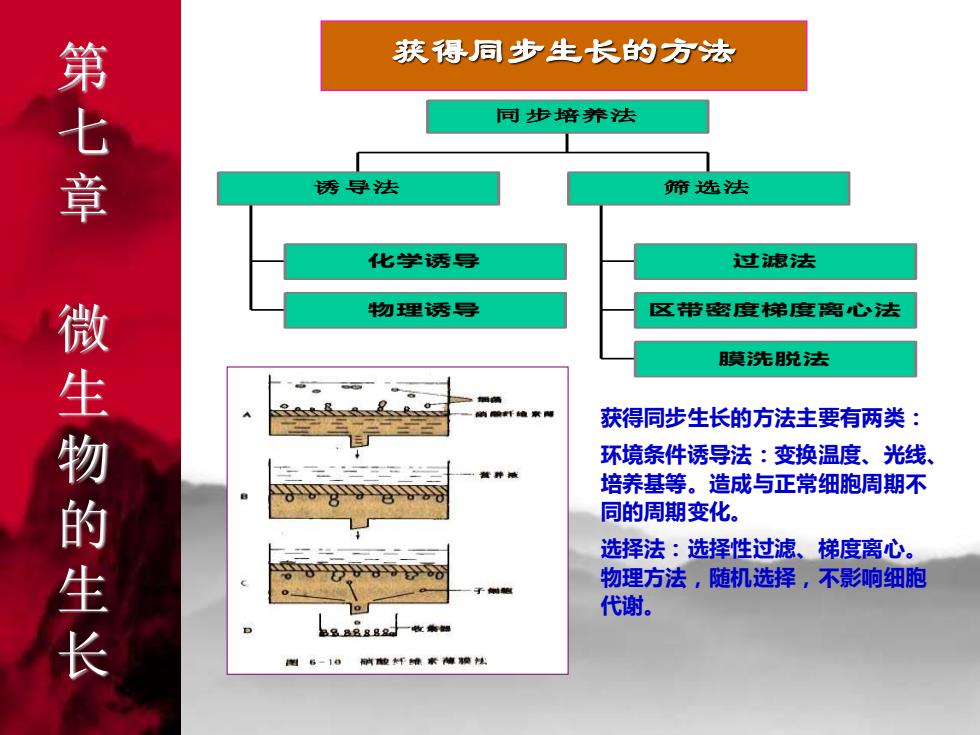
第七章微生物的生长 化学诱导 物理诱导 诱导法 过滤法 区带密度梯度离心法 膜洗脱法 筛选法 同步培养法 获得同步生长的方法 获得同步生长的方法主要有两类: 环境条件诱导法:变换温度、光线、 培养基等。造成与正常细胞周期不 同的周期变化。 选择法:选择性过滤、梯度离心。 物理方法,随机选择,不影响细胞 代谢
第七章微生物的生长 化学诱导 物理诱导 诱导法 过滤法 区带密度梯度离心法 膜洗脱法 筛选法 同步培养法 获得同步生长的方法 获得同步生长的方法主要有两类: 环境条件诱导法:变换温度、光线、 培养基等。造成与正常细胞周期不 同的周期变化。 选择法:选择性过滤、梯度离心。 物理方法,随机选择,不影响细胞 代谢
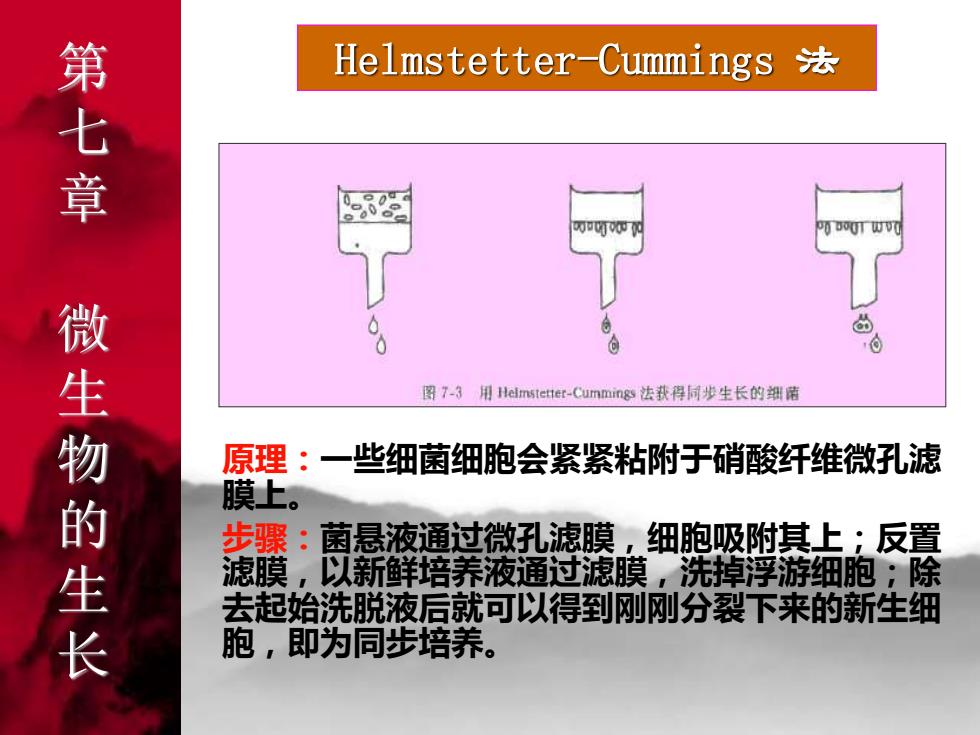
第 七 章 微 生 物 的 生 长 Helmstetter-Cummings 法 原理:一些细菌细胞会紧紧粘附于硝酸纤维微孔滤 膜上。 步骤:菌悬液通过微孔滤膜,细胞吸附其上;反置 滤膜,以新鲜培养液通过滤膜,洗掉浮游细胞;除 去起始洗脱液后就可以得到刚刚分裂下来的新生细 胞,即为同步培养
第 七 章 微 生 物 的 生 长 Helmstetter-Cummings 法 原理:一些细菌细胞会紧紧粘附于硝酸纤维微孔滤 膜上。 步骤:菌悬液通过微孔滤膜,细胞吸附其上;反置 滤膜,以新鲜培养液通过滤膜,洗掉浮游细胞;除 去起始洗脱液后就可以得到刚刚分裂下来的新生细 胞,即为同步培养